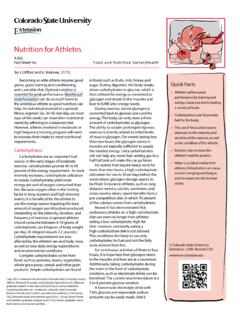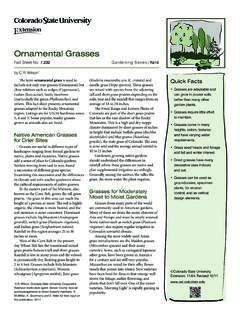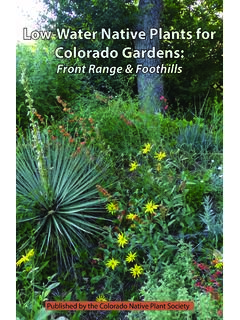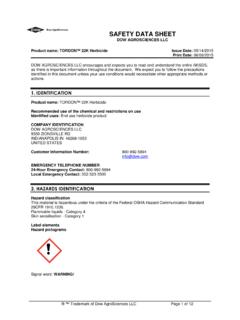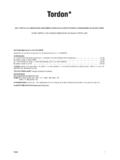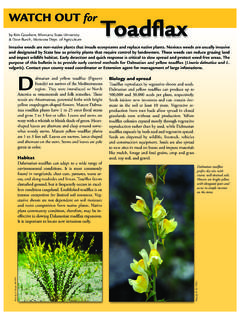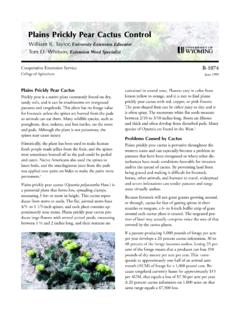Transcription of Canada Thistle - Extension
1 Fact Sheet No. Natural Resources Series|Rangeby Beck* Canada Thistle (Cirsium arvense) is an aggressive, creeping perennial weed that infests crops, pastures, rangeland, roadsides and noncrop areas. Generally, infestations start on disturbed ground, including ditch banks, overgrazed pastures, tilled fields or abandoned sites. Canada Thistle reduces forage consumption in pastures and rangeland because cattle typically will not graze near infestations. In 2002, the Colorado Department of Agriculture surveyed counties and while incomplete, the results showed more than 100,000 acres infested with Canada Thistle (Figure 1).
2 One plant can colonize an area 3 to 6 feet in diameter in one or two years. Canada Thistle grows in a variety of soils and can tolerate up to 2 percent salt content. It is most competitive in deep, well-aerated, productive, cool soils. It usually occurs in 17- to 35-inch annual precipitation zones or where soil moisture is adequate. It is less common in light, dry soils. A survey conducted in 1998 showed Colorado has about 400,000 acres infested with Canada Canada Thistle develops from seed or vegetative buds in its root system.
3 Horizontal roots may extend 15 feet or more and vertical roots may grow 6 to 15 feet deep. Canada Thistle emerges from its root system in mid- to late spring (late April through May) and forms rosettes (Figure 2).The greatest flush of root-derived plants occurs in spring, but another flush occurs in fall. A flush can occur anytime during the growing season when soil moisture is adequate. This is particularly a problem when Canada Thistle growth is disturbed by tillage or herbicides. This feature can be manipulated to the land manager's Facts Canada Thistle is a creeping perennial that reproduces from vegetative buds in its root system and from seed.
4 It is difficult to control because its extensive root system allows it to recover from control attempts. Combining control methods is the best form of Canada Thistle management. Persistence is imperative so the weed is continually stressed, forcing it to exhaust root nutrient stores and eventually die.*Colorado State University Extension weed science specialist and professor, bioagricultural sciences and pest management. 11/2013 Plants that germinate from seed do so at about the same time as root-derived shoots.
5 Seedlings grow slowly and are sensitive to competition, particularly if shaded. Canada Thistle seedlings develop a perennial habit (the ability to reproduce from their root systems) about seven to eight weeks after and spread. Canada Thistle begins to flower in late spring to early summer in response to 14- to 16-hour days (Figures 3, 4 and 5). Plants are male or female (dioecious) and grow in circular patches that often are one clone and sex. Female flowers produce a sweet odor and insects readily pollinate different sexed patches up to 200 feet Thistle develops seed sparingly.
6 It may produce 1,000 to 1,500 seeds per flowering shoot. Generally, vegetative reproduction from its root system contributes to local spread and seed to long distance dispersal. Seed may be transported long distances by water, or attached to animals, clothing, farm equipment and other vehicles, and in contaminated crop seed. Also, wind may help disperse seed, but most often, the feathery pappus breaks off, leaving the seed attached to the parent plant to be dispersed by other means. Seed can remain viable in soil up to 22 years, and deep burial promotes survival longevity.
7 Colorado State University Extension . 2/00. Revised 11 ThistleFigure 1: 2002 distribution of Canada Thistle in Thistle allocates most of its reproductive energy into vegetative propagation. New shoots and roots can form almost anywhere along the root system of established plants (Figure 6). Tillage segments roots and stimulates new plants to develop. Shoots emerge from root and shoot pieces about 15 days after disturbance by tillage. Small root pieces, inch long by inch in diameter, have enough stored energy to develop new plants.
8 Also, these small roots can survive at least 100 days without nutrient replenishment from key principle to Canada Thistle control is to stress the plant and force it to use stored root nutrients. Canada Thistle can recover from almost any stress, including control attempts, because of root nutrient stores. Therefore, returning infested land to a productive state occurs only over time. Success requires a sound management plan implemented over several control. Grasses and alfalfa can compete effectively with Canada Thistle if their growth is favored by good management.
9 Maintain fertility and, if possible, moisture at optimum levels to favor grass or alfalfa growth. Soil analysis can easily determine fertility needs. Be cautious with nitrogen fertilizers, because excess available soil nitrogen may favor weed are essential management steps to ensure optimum desirable plant growth and competition. However, competition alone seldom is effective against Canada control. Read the label, follow directions and use precautions. Research at Colorado State University shows that Tordon 22K (picloram), Milestone (aminopyralid), Transline (clopyralid), Perspective (aminocyclopyrachlor + chlorsulfuron), Banvel/ Vanquish/Clarity (dicamba), and Telar (chlorsulfuron) are effective against Canada Thistle in pastures, rangeland, natural areas, and noncrop settings.
10 Canada Thistle is difficult to control and re-treatment for one to three or more years after the initial application is common. Refer to Table 1 for use rates and application timing and always read the herbicide label before using the product. These herbicides are most effective when combined with cultural and/or mechanical 2: Emerged Canada Thistle rosettes from roots in early 3: Canada Thistle bolting growth stage in State University data also indicates that Banvel/Vanquish/Clarity or Telar are effective when combined with 2,4-D as a split-season 2,4-D, 2 quarts per acre (A), in spring when Canada Thistle is 10 to 15 inches tall, in pre-bud to early bud growth stages.

